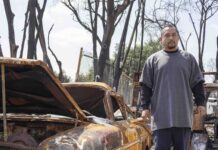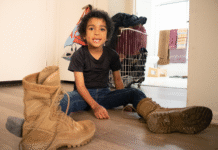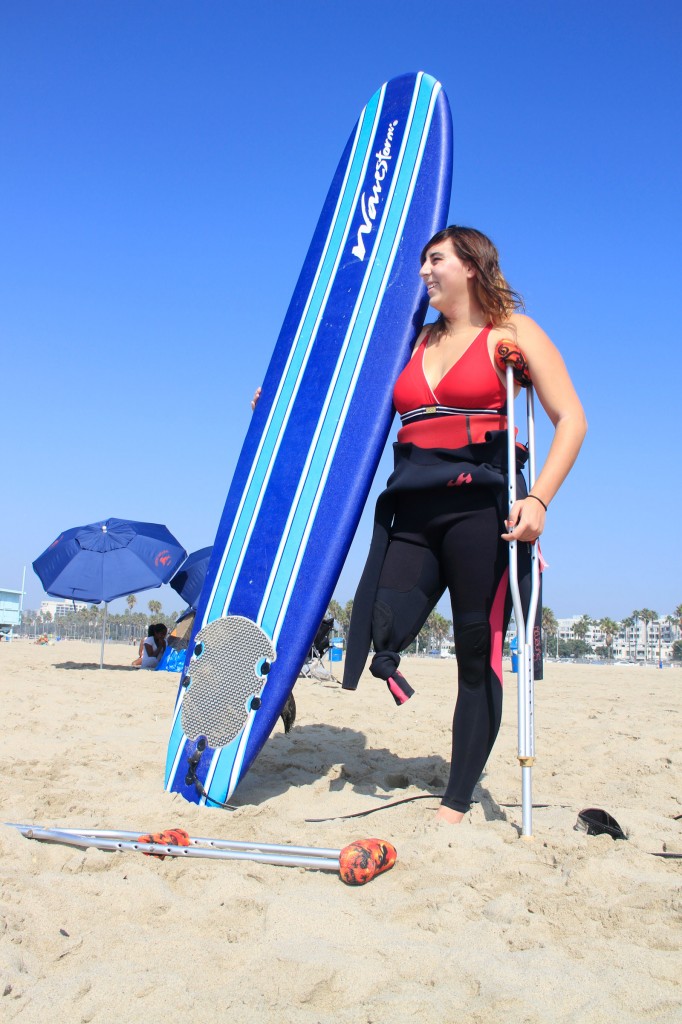
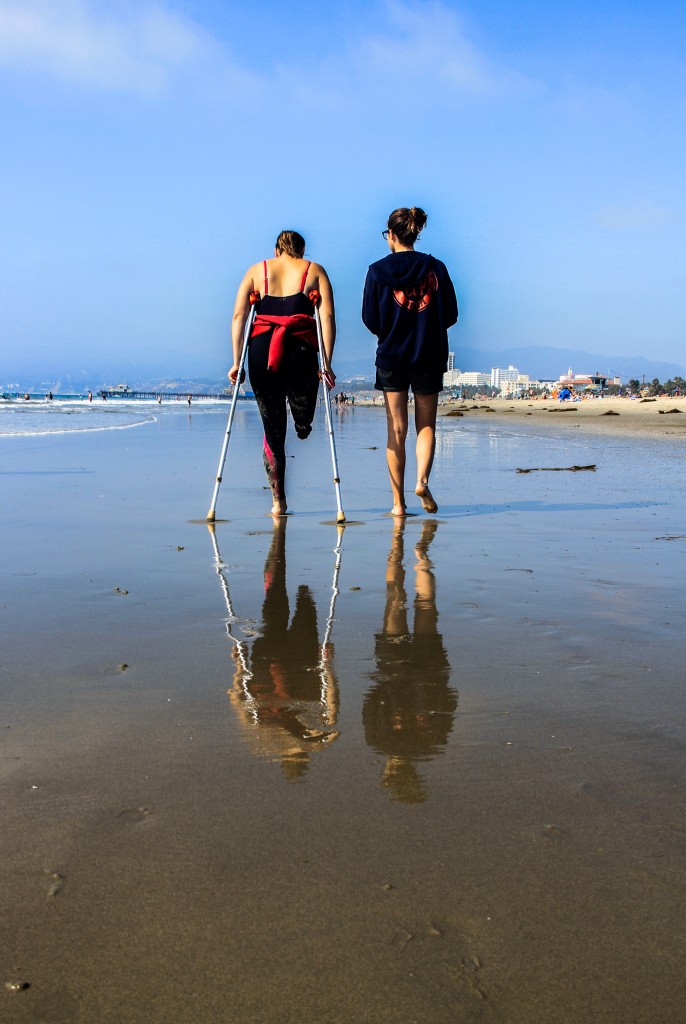
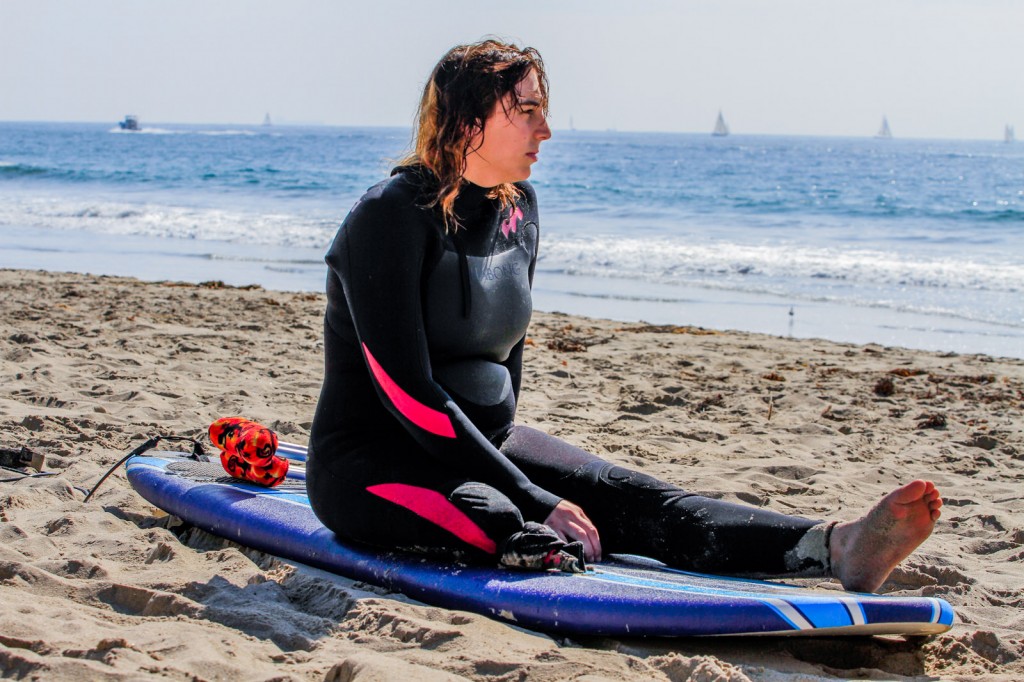
Story By: Kashish Nizami
Wriggling her toes to remove a strand of seaweed, a 20-year-old girl looks out toward the emerald-tinted ocean determined to catch a wave. She studies it for a few moments with her left hand shielding her eyes from the bright sun, before resolving with one swift nod that this time she’s going to do it.
She raises her right arm slightly, allowing the crutch underneath it to fall and then grabs the surfboard buried in the sand beside her. Her 14-year-old sister offers her shoulder for support and they hobble for ten minutes to the cold water. Smiling with sweat beaded above her brow, she drops the board in the water and swims out. After a few rough waves, the girl uses what is left of her right leg to gain balance on the board, before slowly raising her left to try to stand up. After a few seconds of standing, her leg gives out, and she crashes into the ocean. Upon losing sight of her, panic spreads across the faces of the beach-goers who had been staring at the unusual sight, but her sister remains surprisingly calm. Emily treads water fast enough to high-five Lyndsay after she erupts out of the waves with a fist in the air.
Lyndsay Lucas doesn’t quite describe herself as most amputees might. The confident, vivacious theatre and performing arts major spends most of her time with her friends and likes to bowl, swim, surf, rock climb, kayak, and work backstage for performances. And when someone asks about her missing right leg, she likes to tell boys say that it got bitten off by a shark or girls that she’s slowly turning into a mermaid. Ask, and she’ll tell you as she taps the thigh connected to a prosthetic leg that her biggest struggle in life is her dyslexia.
Lyndsay was just 12 years old when she began to have pain in her right knee. It had swelled up, and it hurt to walk. Her parents assumed it was she was overactive; she loved to vigorously play sports and climb trees and was frequently injured.
But it was May 2005 when her pain had begun, and when it still hadn’t subsided by August, her parents suspected that something was wrong. Still, she went to visit her aunt in Yucaipa, and one day they were leisurely walking to a Rite Aid Pharmacy. That’s when her leg gave out from under her, and she fell onto the parking lot’s rough pavement. Lyndsay’s aunt called her parents and told them that she needed to go to a doctor as soon as possible.
Lyndsay went to a doctor who took an X-ray of her knee, and the very next day she received the news that the results did not look good. After visiting a specialist, she and her mother, Ariadne, were told that they needed to go somewhere that would have the resources to help her, and they were directed to Cedars-Sinai. There she was scheduled for a bone biopsy, where a sample of bone was to be taken from her kneecap, around one o’clock p.m., and then she was supposed to go home.
After a few hours, however, Ariadne was told that that would not be the case— her daughter was to be admitted to the hospital immediately. She then met with doctors from almost every field who each asked her specific, thorough questions, ruling out every other possibility. She was then diagnosed with osteosarcoma, a type of cancer that develops from certain tissues from the bone, which was in her right kneecap.
Lyndsay’s mother remembers every detail— from the day of the week down to the time of day— from when the events occurred that year.
“When I found out, I was just beating myself up to no end. ‘Why didn’t I take her in sooner? Why didn’t I take her right when she was saying it hurt?” Ariadne said. “The guilt… They say it’s normal, but as a parent it’s still stuck in [your head].”
The doctors considered Lyndsay lucky, though; most people don’t realize they have osteosarcoma until after the bone or bones actually shatter. In fact, with her swelling, they were surprised that they didn’t break. They asked Lyndsay if she had simply rested all day every day, which of course she had not.
Doctors were quick to recommend treatment, and it was established that Lyndsay would receive chemotherapy. Although it was a dangerous treatment to receive for longer than a year for someone of her age, the doctors later decided to continue on for six more months. They were hoping that the chemotherapy would stop the cancer.
After a few months, reality had set in. She needed to have surgery to remove the entire tumor, but there was a possibility that she might have to have her leg amputated. However, for some reason this didn’t seem to faze Lyndsay—she stayed upbeat and was as happy as a kid in a hotel room on vacation.
The night before her surgery, her aunt painted her toenails so she could have “the best looking toes” the surgeons had performed on, and it’s a memory that resonates with Lyndsay today. But at the time, she wanted a keepsake, just in case.
“They were prepping me for the surgery, and I remember them asking, ‘Is there anything that you want us to do?’” she recalled, barely able to speak from laughing so hard. “I went, ‘If you amputate my leg, can I keep the big toe?’ and the doctor just stood there, and then he looked up at my mom and had that face, like, ‘Is this girl serious?’’”
But while Lyndsay was in high spirits, asking if the doctor would also amputate her Build-a-Bear’s leg too if they had time, her parents and aunt did not know what to expect. Ariadne knew her daughter would be different if she returned without a leg physically—but she didn’t know if that happy girl going in would be the same one waking up from surgery if she lost her leg. They even feared for her life.
“We were just living minute to minute, day by day. I wasn’t going to worry about what was going to happen tomorrow—I needed to get through today,” Ariadne said. “Thinking ahead was just too painful; it was easier to just deal with the here and now.”
When the surgeons finally delivered the news that they could not save her leg or her knee, they said she would eventually need a prosthetic one. In regards to amputation and prosthetics, knees are an extremely important financial factor. Co-Chair of the Medical Board for the U.S.A. Olympic Weightlifting Team Brendan Murray, who has worked with numerous Para Olympians but not with Lyndsay, explained that a prosthetic that has to do multi-joint functions is more high-tech and said that the time-consuming labor put into creating them could be one reason for the high costs.
“If you have a prosthetic that has to have some bend at the knee and at the end where the ankle would be, then that’s going to require a lot more engineering than if you had it at below the knee, where it’s really only acting as a foot at the ankle,” Murray said.
Lyndsay’s prosthetic leg cannot go in water or sand, and it doesn’t allow her to run or jump. But even so, it has a computer chip and needs to be charged each night. The knee alone is worth $50,000. Yet, the fiscal value of her right leg is nothing compared to what the value of what she learned by losing it.
Cancer might have taken her leg, but it gave her something in return: willpower. When doctors told Lyndsay that she wouldn’t be permitted to leave the hospital until she could walk, something sparked in her. She was determined to walk in two days.
The headstrong preteen had a catheter in her, she was on morphine and other pain medications and she was bed-ridden, but she still wanted to get out of the hospital as soon as possible. So her doctor told her what actions she needed to be able to perform before she could discharge.
And so, methodically, Lyndsay went through the list. Her nurses told her it would take about a week for her to sit up. But she did so as soon as she could, and she stopped taking the morphine. She had them take out the catheter, and with the help of her aunt and mother she went to a restroom. She tackled what would take most adults perhaps a few weeks in a day. She would have continued on she says, but the nurses hadn’t prepared for someone to train her on crutches.
“They gave her one obstacle after the other, and she would go, ‘I’m done; now, what’s next?’” her mother said. “Everybody at that nurses’ station was watching her.”
The next day Lyndsay learned how to go back-and-forth across a hallway successfully on crutches before learning how to go up and down stairs. She had worked for hours, but by the end of the second day the 12 year old taught patients, medical professionals, and her family not to doubt the power of ambition.
Her leg was amputated on a Wednesday. By Friday, she was discharged from the hospital and even attended her cousin’s baby shower the next day.
Ambition is exactly what drives Lyndsay to strive to accomplish any physical task—like surfing.
“I don’t want to leave yet!” Lyndsay yells in frustration. “I didn’t even get to ride a wave.” But after a dozen more failed attempts she and Emily resolve to come back another day. She clings onto her board, and her petite, younger sister pulls Lyndsay back up to shore to retrieve her crutches. People stare, but neither of them seem to notice or care. They’re singing skillfully, unapologetically and loudly. As the two return home, Lyndsay grabs her makeup bag from the car and wonders who has the house keys, as she makes her way toward the sound of her four barking dogs. When she reaches the door, she realizes that something is missing. The two ponder for a moment, when suddenly Lyndsay smiles and pleadingly looks at her sister.
“I forgot my leg in the car…”

